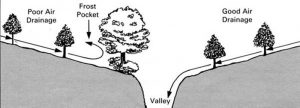Fall is the right time for fruit trees and the 4-H plant sale
Published 12:00 am Friday, October 18, 2019

- Submitted graphic Improper planting on the left and proper planting at the right depth on the right.
By Michael O. Fine
Cooperative Extension
SALISBURY — North Carolina’s climate and soils are well suited to grow many types of fruit bearing trees, canes and bushes. These fruit producing perennials provide landowners with multiple seasons of fruit production while offering landscape aesthetics, shade, buffers and soil retention throughout the year.
Better yet, the 4-H plant sale is underway and offers research-backed varieties that are suited to our local climate.
Site selection
Site selection is the single most important factor in establishing an orchard. Light exposure, soil properties, water availability and temperature extremes/fluctuations are important factors to consider when selecting an orchard site. Paying close attention to these details before planting is crucial.
Sunlight
Fruit trees need full sunlight to achieve maximum fruit quantity, size, quality and coloration. Ensure that trees are spaced for a mature tree size so that they do not shade one another.
Light must reach fruit throughout the tree canopy. Correct spacing, pruning and training will allow light to reach the fruit. Light levels are reduced deeper in the canopy. At least 35% of light interception is required to initiate flower formation and more than 70% is required to produce high quality fruit.
Tree borders should be clear of large trees and brush that can shade trees in the orchard. Cooperative Extension offers a tree pruning workshop during the winter at area farms in order to give producers hands-on experience pruning their fruit-bearing trees and shrubs. Call the local office at 704-216-8970 and ask to be on the office’s listserv to get the workshop information when the classes are scheduled.
Air drainage
Just as proper soil drainage is important for tree roots, air drainage is important for regulating temperature and avoiding stagnant cold air in the orchard. Choose a site that slopes downhill without obstructions. Wooded areas, buildings and fences can cause pooling cold air that can result in spring frost damage. Avoid planting trees too close to these obstructions.

Submitted An example of cold air moving to the lowest point in the orchard. Trees, houses and brush can cause cold air to build up, causing a frost pocket.
For establishing a new orchard site on a property, keep in mind that locations such as a valley or bottomland where the air will pool and settle should not be planted. In many areas of North Carolina we can see a 1-degree difference in temperature for every 10-foot increase in elevation during damaging spring frost/freeze events. A temperature differential of 3 to 4 degrees can be the difference between no crop and a full crop.
When and how to plant
Planting in the fall allows for winter root growth when soil temperatures are above 50 to 55 degrees, resulting in better growth during the first-year establishment.
When the trees arrive, it is important to plant the trees as soon as possible after they arrive. Do not allow the root system to dry out. When digging a hole to transplant your young plants, make sure the hole is large enough to fully incorporate the root system without binding and scrunching the root ball. Replace dirt in the trench while being careful not to bury the plant below the graft union. Compress dirt gently around the base of the plant by stepping on top of the loose dirt with your foot or heel.
Ordering is open now until Oct. 31. To order: go to https://go.ncsu.edu/2019fallplantsale or call the NC Cooperative Extension Rowan County Center at 704-216-8970.
Plant pick-up is Thursday, Nov. 7, from 8:30 a.m.-4:30 p.m. at the Rowan County Agricultural Center at 2727 Old Concord Road. Make checks payable to CES or bring the exact amount in cash.



